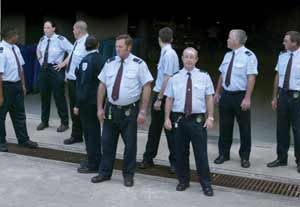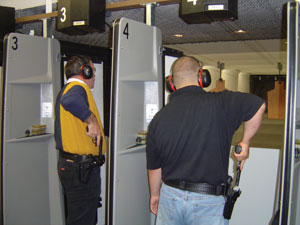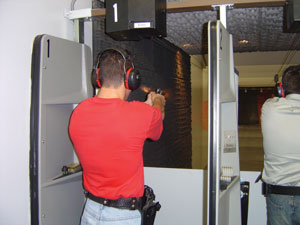Health, safety and handguns in the security industry
by Andrew Marks (proprietor of Marksman Security Training)
In Australia, it is not unusual to see a security officer checking premises or stepping from an armoured car carrying a handgun secured in a holster. How many of us have wondered: Why are they carrying a firearm and what training and operational standards are in place to ensure the safety of the public? To understand the reasons for security officers carrying firearms, we must first understand the function of a security officer.
 Security companies are often employed by individuals or organisations
to meet a shortfall between the security concerns of clients and the
general security services provided by police forces. Police simply
cannot be everywhere and do everything. They also have the primary
responsibility of ensuring ‘peace and good order’ on behalf of all of
society rather than focusing specifically on the individual
economic/security interests of private persons or organisations.
Security companies are often employed by individuals or organisations
to meet a shortfall between the security concerns of clients and the
general security services provided by police forces. Police simply
cannot be everywhere and do everything. They also have the primary
responsibility of ensuring ‘peace and good order’ on behalf of all of
society rather than focusing specifically on the individual
economic/security interests of private persons or organisations.
Firearms are carried when there is a high level of risk involved for a security officer. The most obvious illustration of the requirement to carry firearms is the cash escort/carriage industry, where the value of the item or cash being carried puts those carrying these items at high risk of armed robbery. There is also a heightened risk of terrorism due to the ‘war against terror’, which means that targets other than cash will put security operatives at a much higher risk. Obviously if an incident occurs within Australia, the need for armed security officers will escalate dramatically.
Recent experience shows that many offenders now are armed with knives and/or firearms and as a consequence security officers simply ‘doing their job’ are more likely to be subject to violence than ever before.
Dangerous work requires appropriate protective equipment - a basic OH&S requirement of all industries. Where it is likely that the security officer’s duty exposes them to the risk of ‘death or serious injury’ then a firearm is an appropriate level of protection, provided that the carriage and use of the firearm is in accordance with the law.
Firearms training and licensing
Even though many politicians speak of ‘national gun laws’ the fact
remains that firearms legislation still remains the domain of state
parliaments. Each state, while agreeing to standardise elements of
firearms legislation, still retains enforcement and administration of
firearms legislation and regulation through the various state police
forces and firearms registries.
Security firearms licensing
For all private security firearms licensing in South Australia for
example, applicants must complete an accredited firearms training
course. Before undertaking training, the student must apply at their
local police station for a handgun licence (security industry). The
applicant must provide 100 points of ID to lodge the application. The
application is processed by SA Police (SAPOL) Firearms Branch and takes
a minimum prescribed time of 28 days. Once checked, a letter of
approval from police is sent to the applicant. They then take the
letter to an accredited instructor who retains a copy of the approval
letter on their files. Training cannot be undertaken by the applicant
unless police have granted written approval. Variation on this and the
following requirements apply in other states, but many of the
procedures remain the same.
Overview of training
In SA the entry-level training course runs for four days full-time and
qualifies the student on either a self-loading pistol or revolver. If
the student wishes to qualify on both firearm types, they need to
complete an extra day’s training for the other firearm type.
Once a security officer has completed training, the security firearms-licensed company that employs them must certify to police that the person is an employee of theirs, and that the employee needs to carry a firearm during the course of their employment. SAPOL then, when satisfied that all is in order, issues the individual an H6 (security) licence.
Once licensed, the security officer must undertake three ‘in-service’ training sessions to renew their licence each year. The sessions include an annual qualification shoot and theory test before a new training certification is issued by the instructor. (These training requirements are currently under review.)
If the security officer leaves the employment of their company and does not have an employer to sign their training certification, the licence lapses until such time as the security officer gains employment/sponsorship from another security firearm-licensed security company.
 Course content - entry-level training
Course content - entry-level training
In broad terms there is a theory and a practical component to the
entry-level firearms training course that the student must pass. The
theory element of training is designed to make students understand the
circumstances in which force may be used, legislation related to the
carriage, possession and storage of firearms and offences related to
the misuse of firearms. The practical component of training relates to
the ability of the security officer to achieve a qualification score,
to handle and operate the firearm safely, to comply with the
instructor’s directions and demonstrate a mature and responsible
attitude throughout the course.
Theory element
The ability to draw a firearm from a holster and successfully defend
oneself is only one aspect of the training course. The most important
element of training is understanding the circumstances when it is
appropriate and legally justified to use a firearm for a defensive
purpose.
The ‘what if?’ syndrome
Several key elements must be established before someone uses their
firearm:
- Is there an imminent threat that causes them to genuinely fear for their life or the life of another innocent person?
- Is there an imminent threat that will result in serious injury to themselves or another innocent person?
- Are they able to consider another course of action (ie, communicate, negotiate, retreat, find cover, etc) or another force option or means available other than the use of the firearm? Is the use of force ‘necessary and reasonable’ under the circumstances?
- Is the level of force ‘reasonably proportionate to the threat’ that they ‘genuinely believe to exist’?
- If they use the firearm is there a real risk of injury or death to innocent persons?
It is impossible to predict every possible contingency or circumstance that security officers may find themselves in. The decision to use force will be closely scrutinised by police and therefore the security officer must be able to explain his/her conduct as being within the above guidelines. The basic elements listed above are a ‘checklist’ that a security officer must answer before the use of the firearm.
Students often say, “well, what if…?” and expect a definitive ‘yes’ or ‘no’ to the plethora of scenarios that they can think of. As discussions continue, it is interesting to see the misconceptions evaporate as students realise the responsibility placed upon them. Ultimately, it is the security officer who must make the decision to use the firearm based on what they see, what they hear, what they perceive the threat to be, and what they believe to be the best course of action. Once they make that decision, they should be able to properly justify their actions to the police and the courts.
In South Australia, Section 19 (1a & b) of the Criminal Law Consolidation Act defines the legal circumstances in which any person may consider the use of force to defend themselves. It is important to realise that this section applies to ordinary persons faced with violence as well as security officers. It does not simply justify the use of firearms but also batons, handcuffs, etc, as long as it is appropriate to the level of threat - that is for a defensive purpose and there were no reasonable alternative options.
Firearms and other legislation
There are other issues a security officer must consider when carrying
firearms in public environments. Any person who owns a firearm must
consider themselves as being under a higher level of scrutiny than most
members of the public. Carrying a loaded firearm in a public place is a
big responsibility!
Storage and security requirements for firearms and ammunition in the security industry are similar to those of private firearms owners. Security officers carry company-issued firearms that are signed in and out daily. However, if the security officer is in possession of the firearm and fails to secure it in accordance with the firearms legislation, police action would most likely follow.
Security officers also have to show great caution in their conduct in public. They cannot afford to be goaded into verbal confrontation while carrying their firearm as comments made may be construed as threatening. Tactical communication skills and conflict resolution skills are a vital part of the officer’s training.
The final examination on the theoretical components consists of 40 questions set by SAPOL. This tests the student’s knowledge regarding firearms safety, the justification and circumstances in which the student may consider the use of force. The student must achieve a minimum of 35 correct answers; the first 18 questions must be correct as they relate to the legalities of firearms possession and justification of use of the firearm.
 The practical element
The practical element
The practical components of the entry-level course are designed to give
students the ability to successfully operate the firearm in a safe
manner and to use associated equipment such as security holsters and
speed loaders.
Initially, students are shown the different types of handguns used in the security industry and their operating parts (or nomenclature). Then the students are issued a duty belt and holster to suit the type of handgun they wish to qualify on.
Before taking to the firing line, students are briefed on the range commands that will be used to conduct the firing exercises and the safe handling of firearms. Once on the firing line, instructors demonstrate basic skills such as proving the handgun is safe, loading and unloading. The instructors then demonstrate the fundamental skills of defensive shooting and correct techniques for drawing the firearm and recovering the firearm to the holster safely.
Most of initial firearms training is conducted in a ‘dry-firing’ capacity; this means the student has to practise drawing and operating the firearm without ammunition. This allows students to develop confidence and consistency before undertaking live firing.
Firing exercises concentrate on developing speed and accuracy. Students fire multiple shot exercises and at multiple targets. All shots fired during the practical test must hit the target with a minimum of 34 out of 40 shots being placed in a smaller inner target area known as ‘the centre of seen mass’. Again, it is important to highlight that the purpose of discharging the firearm is to immediately incapacitate the identified threat.
Firearms retention is also taught. This gives the security officer the ability to prevent an offender from removing the firearm from the holster and using it against the officer or other persons.
Future trends
The future of handguns being carried by security officers is far from
clear. SA Police (along with other states) has established a working
party to examine the use of firearms within the security industry.
Presumably this is a response to a few well-publicised cases of theft
of firearms from police stations, military bases and security companies
around Australia during the past few years.
For the security officer it is a most important occupational safety issue. Provided they are properly trained and licensed, they should not be deprived of the use of a necessary and legitimate item of protective equipment that is used every day of the week. It is hoped that the working party will remain objective, and that the issue does not become politicised in the process.
All parties in this debate need to keep in mind one thing when it comes to this issue: What is in the best interests of the individual safety of police and private security officers involved? We need to ensure that those who want to ban guns ‘at any cost’ do not succeed in removing firearms from our police, military and security officers under any circumstances. Given recent world events, the need for individuals working in these occupations to carry firearms as part of their job has increased, not decreased.
